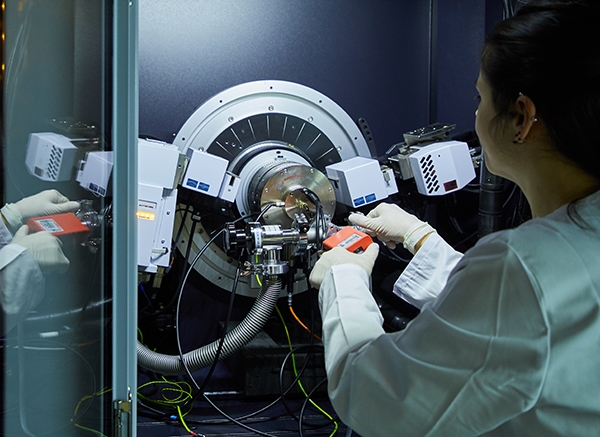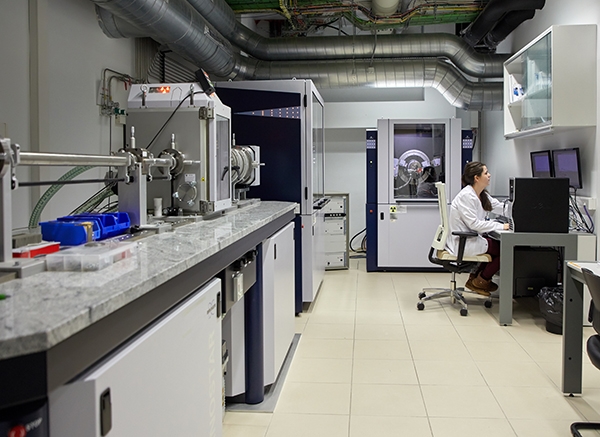
IVAN BOBRIKOV
PLATFORM MANAGER

PLATFORM MANAGER
The X-ray diffraction unit is composed of two diffractometers Bruker D8 and a Bruker Nanostar SAXS instrument. This allows to cover the analysis of a very broad range of length-scale, from the atomic crystalline lattice to the morphological information at nanometer scale and including microstructural features. The three instruments can be equipped with an electrochemical cell allowing in-situ or operando study of the changes in the active materials for electrochemical storage as a function of their state of charge and discharge. The Bruker D8 diffractometers can also be equipped with two temperatures chambers allowing to cover a broad range of temperature from -190ºC to 1200ºC. The platform’s mission is to offer service to the various research teams of CIC energiGUNE, maintain its equipment at the state of the art and develop new analysis methods. The platform is also open for external users or collaborators, from both the academic and industrial sections, and offers trainings to its internal as well as external users and collaborators.

The D8 diffractometers are all-purpose X-ray analysers which can be configured for a great of range diffraction applications: powder diffraction, including phase identification and quantitative phase analysis, micro-structure and crystal structure analysis, film analysis, residual stress and texture investigations. The systems can operate in both divergent and parallel beam geometries and are equipped with a LYNXEYE (ADVANCE) and LYNXEYE XE (DISCOVER) one dimensional detectors. Both D8 diffractometers are equipped with photon energy discrimination to filter out fluorescence. The DISCOVER is equipped with a monochromator system which removes K-α2 radiation for a true monochromatic input beam suitable for highly crystalline materials, which, combined with its new generation detector, increases the signal/noise ratio and significantly enhance the detection limits of minor phase amounts. Temperature chambers are available for these diffractometers for a broad range of temperatures (-190ºC-1200ºC) and under different atmospheres (Nitrogen, Helium, Oxygen, Air, Vacuum). Special accessories such as air-tight sample holders, zero background monocrystalline silicon sample holders and capillary stage are also available.

SAXS (Small-Angle X-ray Scattering) is a reliable, economic and non-destructive method for analysing poorly crystalline or nanostructured materials, yielding microstructural or morphological information from the molecular scale up to the tens of nanometres. SAXS can allow studying for instance the low angle diffraction peaks of poorly crystalline materials as well as the topology of microporosity or nanoparticles. In the Bruker Nanostar a brilliant X-ray source is combined with innovative multi-layer optics, which, combined with the 3-pinhole collimation method, provides an intense, point-like incident beam upon the sample. This and the fully evacuated beam path allow for an extremely low background, which is a must for the analysis of weakly scattering samples. It is equipped with a large VANTEC-2000 2D detector with true photon counting ability, featuring a maximum performance in angular resolution, low background and dynamic range. Such a large 2-dimensional detector is essential for SAXS measurements as it avoids any potential misinterpretation of data, eliminating the need for restrictive initial assumptions about the sample. Additionally, a real space image the sample can be taken by performing mapping of the SAXS intensity with µm resolution.

The three instruments, D8 Advance, D8 Discover and SAXS Nanostar can be equipped with our in-situ electrochemical cells that have been developed by the X-ray diffraction unit. This allows to study the structural, microstructural and morphological changes in the active materials for electrochemical storage as a function of their state of charge and discharge. Our cells can also be used with success for synchrotron experiments, such as high-resolution diffraction, spectroscopy or SAXS.

If you want to know the latest trends in energy storage and new developments in research, subscribe.

If you want to join a top-level team, collaborate with specialists in multiple disciplines or tell us about your concerns, don't think twice...